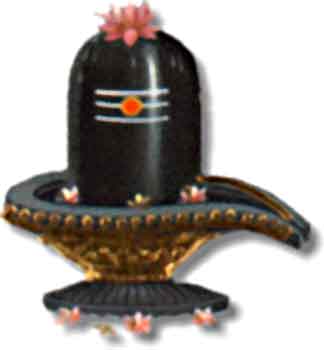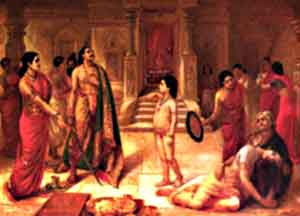 The stories of vratas revolve around its specialty and its fruition after its observance. The vratas include Ekadashi vrata, Dvadashi tithi, and Purnamasi tithi and so on. The observance of these vratas brings punya that is far in excess of any punya that can be obtained from the performance of famous yajnas.
The stories of vratas revolve around its specialty and its fruition after its observance. The vratas include Ekadashi vrata, Dvadashi tithi, and Purnamasi tithi and so on. The observance of these vratas brings punya that is far in excess of any punya that can be obtained from the performance of famous yajnas.
King Rukmangada was Vishnu"s devotee. He strictly observed Ekadasi vrata and made all his people follow it. Consequently, nobody went to Yamaloka. Yama went with Sage Narada and informed Brahma of everything. To break his Ekadashi vrata, Brahma created Mohini, a very beautiful lady, and sends her to Mt. Mandara. One day, he reached Mt. Mandara where he saw Mohini, worshipping the Shivalinga. He was attracted by her and wished to marry her. As demanded by her, Rukmangada promised her that her desires would be fulfilled. While returning to his palace he saw a house-lizard, torn under the roof of his horse, and helped it attain Vaikuntha by parting with a portion of his merit of Sruvana Dvadaii vrata. Rukmangada`s wife Sandhyavali and son Dharmaagada received king Rukmangada and Mohini with due honour. Rukmangada enjoyed life with Mohini. One day, Mohini compelled Rukmangada to fulfil his promise of taking meal on Ekadasi day. As he was not prepared for it, she suggested another to cut off by his son Dharmangada"s head in her presence. Due to mental agony he took the sword in his hand and was about to cut off Dharmarigada`s head, when Lord Vishnu appeared and stopped him from doing so. He took Rukmangada with all his followers to Vaikuntha. When Rukmangada`s preceptor Vasu, who was practicing Yoga in water for twelve years, came out of the water and heard about Mohini"s actions, he cursed and turned her into ashes. Mohini, shed off her human body, started towards heaven, but she was pushed back and put in the hell by Vasu. Brahma, Siva and other gods requested Vasu to free her from the curse and provide her a place. Vasu allotted a place to her on Ekadah afflicted with Dasami, commanded her to move along with the rays of the Sun and the Moon. He also allotted to her the merit of Ekadashi vrata performed by others on that day. As instructed by Vasu, Mohini visited all the tirthas, worshipped gods and offered Dana to Brahmins. At last she entered the Kalindi water and never returned there from. Thenceforth she is seated on the last part of Dasami and spoils the vrata observed by people on Viddha Ekadah. Rukmangada`s in his previous birth previous birth was a Shudra. Once he met a Brahmana with whom he visited many holy places observing several vratas like Asanyasayana and Ekadasi. Consequently he was born as king Rukmangada.
 On the banks of Narmada River, Bhadrasila, son of Galava, a Brahmana, worshipped Vishnu from his childhood. He also preached the greatness of Lord Vishnu and Ekadashi vrata. One day, asked by his father, he narrated the story of his previous birth thus:
On the banks of Narmada River, Bhadrasila, son of Galava, a Brahmana, worshipped Vishnu from his childhood. He also preached the greatness of Lord Vishnu and Ekadashi vrata. One day, asked by his father, he narrated the story of his previous birth thus:
In his previous birth he was a lunar king, named Dharmakirti, and ruled his country for nine thousand years. Once, while hunting he reached the banks of river Reva and observed the Ekadashi Vrata along with other people. Next day, he died and the merit of the vrata secured him a position in Vaikuntha. Subsequently, he was born in a family of the devotees of Vishnu.
There was a Brahmin woman who in order to bring her husband under her control gave him a mantric medicine secured from a nun. On consuming that medicine her husband got infected with tuberculosis. After some time, she passed away. Due to her evil deeds against her husband she had to undergo suffering and punishment in hell. Thereafter she passed her life as a house-lizard for ten thousand years on the earth and was crushed under the hoof of the horse of Rukmangada, who was returning to his palace from Mt. Mandara with Mohini. Hearing the story from the house-lizard, Rukmangada became very kind to the lizard hearing its story and helped it attain salvation by giving a portion of the merit of his Sravana Dvadasi vrata.












